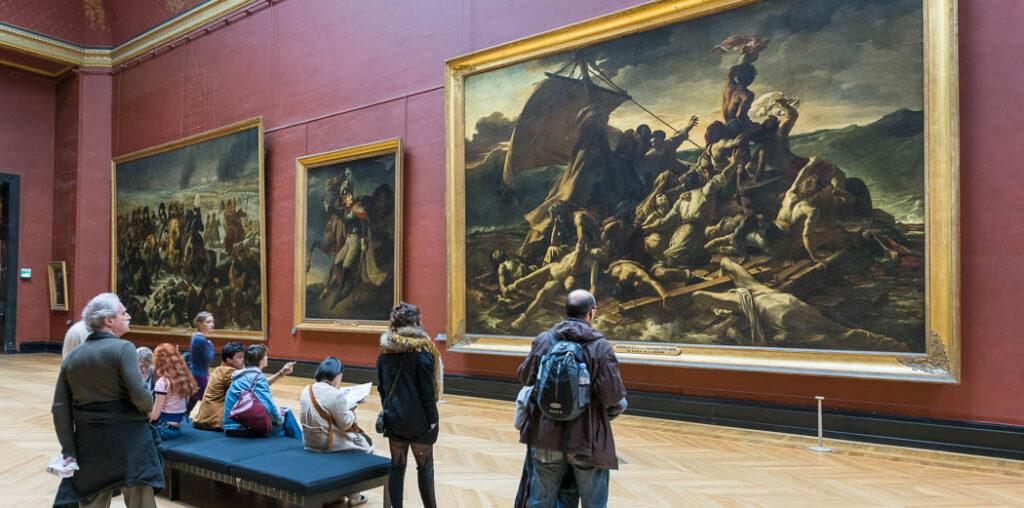“The Raft of the Medusa” is one of the most striking and impact artworks in the history of art. Painted by the French Romantic artist Théodore Géricault in 1818-1819, this massive work-measuring about 16 feet by 23 feet-taps into an infamous shipwreck that was turned into an international scandal in France over charges of corruption, survival, and human suffering on an epic scale. Géricault’s work portrays the horrific tale of the survivors of the wreck with great intensity such that it moves beyond both subject and style boundaries in art.
Background of the Painting
“The Raft of the Medusa” is a real incident occurred in 1816. A French frigate, Méduse, was leaving toward Senegal with settlers and soldiers for the newly established French colony. But, under the command of a lazy and political appointee captain, Hugues Duroy de Chaumareys, the Méduse ran aground on a sandbank off West Africa’s coast. As there were not enough lifeboats for the full complement, in a move to survive, 147 people were placed on an improvised raft.
For almost two weeks, starving, parched, exposed, and killing each other over scraps of food and water, there was little reason to survive when nearly all had been given up for dead. When rescued, only 15 remained alive. Public indignation ran high when the full details of this catastrophe reached France. Scandalous allegations emerged that the government was recklessly and corruptly appointing an unsuitable captain to lead such a crucial mission. Géricault decided to immortalize this tragedy, ensuring that the moral, physical, and emotional suffering of the survivors would be wholly brought to life in a way that would really connect with the audience.
Géricault’s Pilgrimage and Research
Shocked by the Medusa shipwreck, Géricault created a powerful work to convey its horrors and human resilience. He did thorough research on the event; he interviewed people who survived and read accounts of the tragedy firsthand. Géricault also approached the depiction of suffering of the human body scientifically. For his subject, he visited morgues and hospitals to study decaying flesh and emaciated figures.
Months on studies and sketches were spent, especially on anatomy, composition, and lighting. Géricault aimed to do more than document the event; he wanted viewers to feel the agony and despair.
Composition and Symbolism
The composition of “The Raft of the Medusa” is dynamic and complex, relating life and death, hope and despair. Géricault has disposed the bodies on the raft in a pyramid-like construction, so that the eye of the spectator moves from the front through the pile up to the figure of Jean Charles-who is a Black man-ringing for help at the top of the human pyramid. This is the last hope of the survivors because he signals to a distant ship hoped to save them.
The lower half of the painting darkens with chaotic, twisted bodies and agonized expressions, symbolizing survivors’ despair. Browns, grays, and blacks dominate the color palette, contrasting significantly with the pale, almost ghostly skin of the dead and the dying. This dark, brooding palette captures the stark reality of the event by drawing the audience into the visceral horror of the scene.
Such a striking element of the painting was Géricault’s deliberate action to deploy a myriad of figures but instead more on Jean Charles, who happened to be the Black figure. Some art historians interpret this as a political statement; perhaps even an anti-slavery message since this painting quietly makes reference to racial injustice and inequality through portraying a man of African descent as the central figure in a scenario of survival and hope. This element was making the painting complex, beyond a mere historiographic representation, to a greater social and political one.
The Influence of Romanticism
The Raft of the Medusa embodies Romanticism, emphasizing emotionalism, individualism, and the sublime—humanity’s awe and fear of uncontrollable forces. Romantic artists often made subjects that highlighted the strongest human feelings as well as the vast power of nature, which was often terrifying, and Géricault’s painting does just that. The towering waves, the dark sky, and the helpless figures on the raft create a feeling of both awe and dread.
Romanticism would also strive to exhibit the darker consciousness of the human mind, and “The Raft of the Medusa” does this by showing the audience lamentations over despair, death, and cannibalism. The suffering of survivors evokes intense poignancy, drawing the audience into their despair and the hopelessness of the raft.
Techniques and Style
Géricault’s technical mastery is present throughout the painting in the detail, lighting, and use of color. He varies his brushwork: loose and energetic in the background, tight and precise in the faces and bodies of figures. This variance brings life and movement to the scene and enhances its drama.
Dramatic lighting greatly enhances the emotive power-this is one of the features of painting: Géricault uses chiaroscuro, the contrasting play of light and dark, to set dramatic front-lit bodies of the dead against a silhouetted background of turmoil. The source of the light itself is invisible, perhaps a divine or a natural force, that survives cannot control easily. This play of light and shadow conjures up both the material and emotional turmoil of the event.
Public and Critical Reception
“The Raft of the Medusa” caused a scandal in the Paris Salon in 1819. The brutal realism of the painting and its monumental scale shocked and moved the public. Critics praised Géricault’s bold subject and technique, while others condemned its raw portrayal of human suffering and political implications. Géricault’s contemporaries recognized that he was pushing artistic boundaries, as most large-scale works then focused on historical or religious themes. Géricault chose a contemporary event with political overtones, making a powerful intervention of art in public affairs.
By the end, The Raft of the Medusa gained recognition as a landmark in French art, reshaping artistic expression. The Raft of the Medusa influenced later Romantic artists like Delacroix, who embraced Géricault’s emotional themes.
Legacy and Influence
*The Raft of the Medusa* is both a masterpiece and a potent social commentary, resonating across ages. By combining survival, human suffering, and societal darkness, it influenced a series of works by artists. Géricault elevated a contemporary tragedy to high art, setting a precedent for artists to address political issues.
Today, *The Raft of the Medusa* resides in the Louvre, where people still come, captivated by its intensity. The painting’s legacy lies in its ability to evoke empathy, prompting reflection on human fragility versus nature. Géricault’s masterpiece actively challenges unsettling truths and showcases the resilience of the human spirit in unimaginable hardships.
Conclusion
Géracault’s “The Raft of the Medusa” is one of the most powerful and evocative paintings in all of Western art. Through research, skill, and fearlessness, Géricault created a work that documents tragedy while critiquing political systems. Raw realism combines emotional depth, inviting viewers to confront survival’s harsh realities, hope, despair, and resilience.

